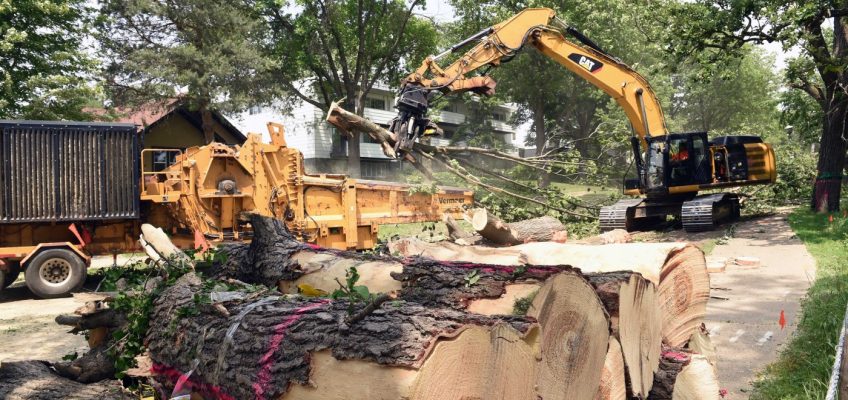When St. Paul Public Works or their contracted crews take down trees for a city project, they may soon have to replace them on at least a one-to-one basis, or make an equivalent contribution to a tree replacement fund.
A city ordinance proposal sponsored by Council Members Rebecca Noecker and Nelsie Yang requires St. Paul to write up a tree preservation plan during public construction projects, with the goal of preserving trees located within public parklands or the city right-of-way, including documented efforts to protect roots and soil.
When preservation isn’t feasible, the “Tree Preservation for City Sponsored Projects” ordinance requires the city to replace removed or damaged trees with the same number of trees and within the same construction site, if possible. Otherwise, the department would be expected to make a contribution to the city’s tree replacement fund, with the goal of planting more trees down the line.
“We’ve been hearing for a long time how much trees matter to people,” said Noecker, the incoming council president, at the close of a Jan. 22 public hearing. “There’s absolutely no intent on my part to rush this through.” In light of significant written comments, she called for the proposal to be revisited by the council on Feb. 26.
Thorny issue
The question of who speaks for the trees has become a thorny one in some corners of the city. Especially for residents opposed to a long-proposed bikeway and sidewalk-level path that could remove hundreds of trees along historic Summit Avenue.
Public Works officials have said the avenue is overdue for reconstruction, and most of the impacted trees will have to be removed anyway.
It’s also unclear how the council’s latest tree preservation proposal impacts projects in which the city has some stake but plays a lesser role to the county, state or federal government, or railroads and private utilities.
In 2023, Ramsey County removed roughly 160 trees from a mile-long stretch of Cleveland Avenue, to the chagrin of homeowners who had been told only 55 trees were to be impacted by road reconstruction. The county then committed to replacing 70 trees, with the expectation the University of Minnesota would replace additional trees along its right-of-way.
Supporters, detractors
The proposed tree ordinance has drawn the support of nature lovers like Friends of the Mississippi River and Great River Greening, as well as the Ramsey Hill Association. It’s drawn criticism from Thomas Darling, president of the Summit Avenue Residential Preservation Association, and others concerned that it does not go far enough to protect trees from removal. They point out that St. Paul Public Works will be writing up the rules outlining what feasible preservation looks like, rather than seeking review over what trees can be saved from independent experts.
“By failing to create any standard for feasibility, and allowing the city to in essence police itself, the ordinance has the very real potential for self-dealing with no meaningful public input,” wrote Summit Avenue resident Chris Schirber, in a Jan. 22 email to the city council.
He and other critics expressed concern that the ordinance proposal, as written, may conflict with the Minnesota Environmental Rights Act, which prohibits the impairment or destruction of natural state resources unless there is “no feasible and prudent alternative.”
Summit Avenue bikeway opponents with Save Our Street, or SOS, have called for daily monitoring of tree impacts during city construction projects, as well as post-construction measurements to determine any lasting impacts.
“A tree preservation policy for St. Paul — good only if it’s enforceable,” reads a notice from SOS. “Otherwise, it’s coffee table material.”
Noecker and Yang’s proposal notes that standards for tree care are laid out in the American National Standards Institute A-300 Tree Care Standards Manual. Noecker last month noted that the rule-making process around preservation would be “opaque” and also rely on further public input.
Fewer trees, hotter temperatures
The council members’ proposal points to the city’s 2019 Climate Action & Resilience Plan, which notes that the greatest risk of exposure to extreme heat is in areas across the city with less dense vegetation and tree canopy cover. That includes portions of downtown St. Paul, Frogtown, the Greater East Side, Dayton’s Bluff and the southern edge of Highland Park. Some of those areas also are low-income neighborhoods with high populations of people of color.
The ordinance proposal also notes that “a healthy tree canopy is vital to every city neighborhood” because trees improve urban air quality, lower surface temperatures, reduce cooling and heating costs, reduce greenhouse gases, provide wildlife habitat, increase property values, enhance the appearance and attractiveness of the city and “positively impact the mental and physical health of city residents and visitors alike.”
Recently, Ramsey and Hennepin counties were chosen to participate in the National Oceanic and Atmospheric Administration’s “Urban Heat Island Mapping Campaign,” an effort to map the hottest neighborhoods in 14 U.S. communities and four international cities.
The temperature study, which was conducted July 27, one of the hottest days of the summer, found that highly developed urban areas such as downtown Minneapolis and downtown St. Paul registered higher temperatures than other areas throughout the day and evening.
On the flip side, areas with high concentrations of street trees, greenspace and water — including neighborhoods near Lake Harriet in Minneapolis and Vadnais Lake in Vadnais Heights — enjoyed cooler temperatures. The Twin Cities study involved more than 125 volunteers taking measurements along 32 routes in the morning, afternoon and evening.
Related Articles
Crime down 6%, ridership up 6% on Metro Transit year-over-year, officials announce
MN DVS counter leaves St. Paul’s University Avenue for Transfer Road
B Kyle: On public safety in St. Paul: progress made, more work ahead
Letters: Walz was critical of Trump funding reviews. We could have used more of our own
Newspaper delivery delayed by up to two hours on Monday


Leave a Reply